Last summer, I shared my method for using Traktor cue points. This time I'm going to show a real-world example of this method by going over the cue points I used in my recent mix, The Titan Festival.
The mix has 25 tracks so this is going to be a long read. Make some tea and take your time. A few thing to think about:
1. You don't have to read everything. The screen captures tell the story; the text is just for details.
2. These are mostly harmonic mixes. Only a couple mixes are not harmonic and were actually used to break up the flow and redirect the mix. Check out the key progression via the Camelot Notation values under the artist name.
3. I used many different mix styles - breakdown transitions, 64-count mixes, minutes-long layered mixes, hard cut-aways, etc. All of these were determined by how the tracks' structures worked together, not just what I felt like doing at the time.
4. I don't play full tracks. There's 26 tracks in 78 minutes, which averages 3 min each. In most cases I only use one section of the track, and it's often the latter section. They're not all 3 minutes long either. A few tracks play less than two minutes, while others are played almost entirely. Changing song lengths helps reduce listener fatigue. Mix it up but stay focused on the juicy center.
5. Each track is selected to build off of the previous one. I used over 40 iTunes playlists to organize this mix including almost 10 source lists and over 30 mix arrangements. I'd arrange what I think works and then try it out in a mix. Then repeat. I left a ton of great tracks on the cutting room floor.
Ready? OK, let's do this.
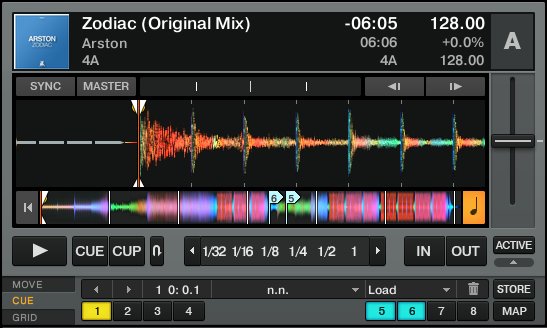
1. Zodiac
The track has a natural "rising from nothing to massive" style so it's a great open.
Mix in: Since this is the opener I didn't need mix-in cues, just a load cue (#1) so I could always start at the beginning.
Mix out: two cue points. #6 is my starting point. #5 is a soft fade out - you'll notice it's blue which tells me exit here, but doesn't have to be a hard cut by this point.
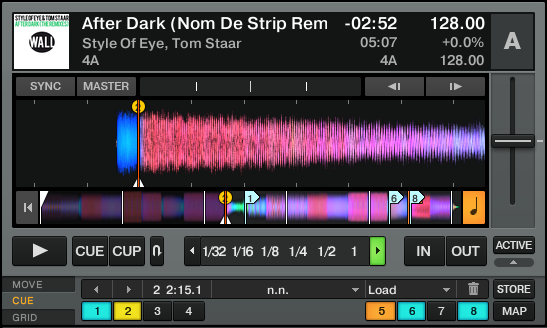
2. After Dark
It's a really campy track that normally wouldn't work, but excelled at going "one step higher" than the open and offering a friendly feel that then descends into Nom's hard grind fun. Such contrast. If this was a story, it would introduce the conflict.
Mix in: I used the breakdown to transition to a vocal hook into a friendly hook builder. My trigger point is a 2, which means you can hear the drop, but not loud. The background sounds complement each other. #1 is when the vocal comes in and the previous track should exit.
Mix out: #6 is the trigger point and #5 is a hard exit. Cue #8 is there as a signal that #5 end four beats prior to the end of the phrase, to allow the drop hook in the next track to stand out.
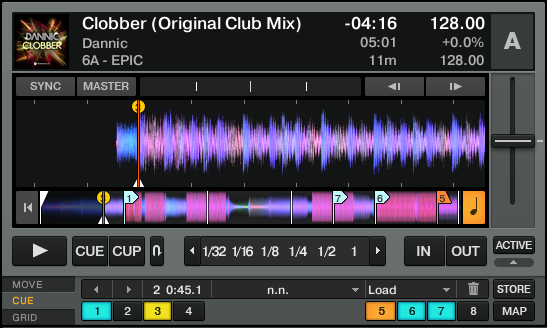
3. Clobber
The cut from After Dark into Clobber is huge. If this was a story, the drop would be the "look" that kicks off the first big action sequence. The downside is I'm about to play three hard tracks in a row (Clobber, Yarl, Chasing Summers) which is pretty heavy handed - particularly for casual listening. But it also set a tone that would contrast well with the big vocal choons, and foreshadow the hard stuff near the end.
Mix in: Trigger is #3, so I start mixing quietly. It's a snare build-up, so I'll ramp it in for the last 16-count and cut on the screeching brakes followed by "Go!" just before cue #1.
Mix out: long mix out. Cue #7 is trigger, #6 is long blend, and #5 is hard exit just before the next track's breakdown.
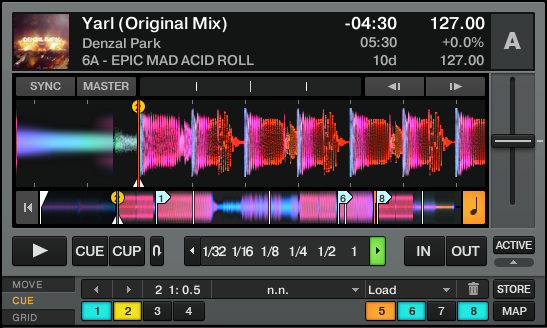
4. Yarl
Loved the 303s - they ride on top of Clobber so well.
Terminology note: I tend to use the word "vocals" to indicate when lyrics are sung, as opposed to "vox" for repetitive voice-based sounds and samples.
Mix in: Trigger is #2 so you can hear some of the percussion. #1 is full volume, but doesn't stop here. I keep the mix going, allowing the heavy 303 bassline to grow on top of Clobber's big orch hits. I cut away a couple of times for Yarl's vox stabs.
Mix out: #6 is trigger. #5 is hard exit, 4 beats prior to end of phrase #8.
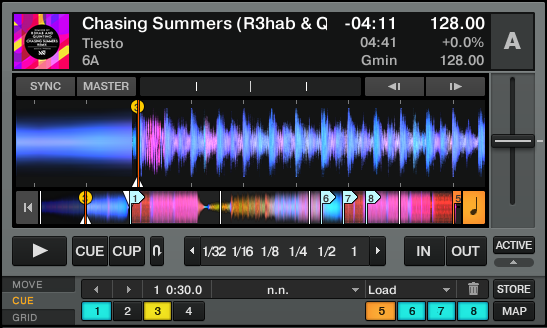
5. Chasing Summers
I don't really care for this track - it makes the hard section last too long and the breakdown is meh on small speakers. But on a big system the breakdown is huge and the exit is just the right level of muted drive to set up the next track, Superman.
Mix in: Another heavy snare build-up. Starts quiet as #3. Ramps up during mix. A lot of tension in this one so I let it drop out a few times to release and squeeze a little more. #1 is start of first main phrase.
Mix out: four cue points for a long mix out. #6 is the trigger, #7 tells me when Superman's vocals come in, #8 is the vocal ride. #5 is almost at the end, reminding me to let Summers play out, but not quite completely.
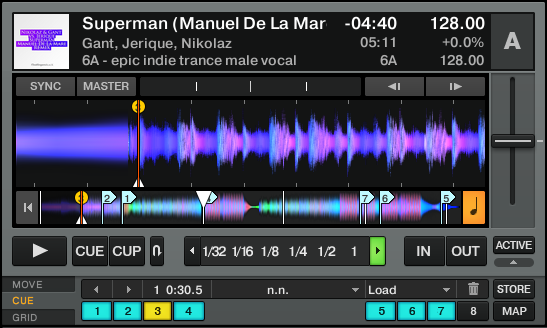
6. Superman
I really like this track, but it's a little under-powered. Summers gives it a lot of heft coming in, so I had to keep Summers in the final mix or redo everything.
Mix in: First major vocal ride. #3 is the drop so I'm ready to intro the vocals at #2. There's still some background sound, so I'll drop Summers volume a little here. #1 is when the main vocal passage really starts. I keep the entire vocal breakdown on top of Summers driving beat, fading out only for the final build-up.
Mix out: Big mix time - both tunes going to be hot and hard. #7 is the start trigger, #6 is when the vocals hit. Because of the high levels of both tracks, I drop the volume. #5 is way out there at the end of the track to tell me it's going to play out to the end and don't worry about cutting away.
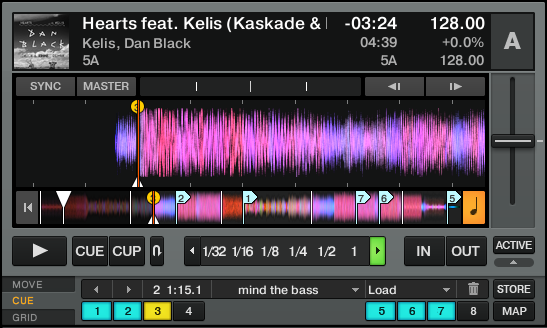
7. Hearts
Another massive yet campy track. Vocals are gorgeous, but probably played to death by junior DJs. I skip the known male vocal and go right to the raspy-reprise female vocal in the last half. The mix in goes massive high and low - big strings drop down to almost silence for a moment, which I tried to capture by cutting into the silence each time as best I could.
Mix in: Tricky mix in. #3 is the drop lead into vocals at #2. Big huge vocal chorus here with even bigger strings. But both tracks are really intense ath this point, so bass is still reduced and track isn't played in full until the breakdown at #1.
Mix out: another vocai lead coming in and the current track is peaking. #7 is trigger, #6 is vocal, and #5 is soft exit.
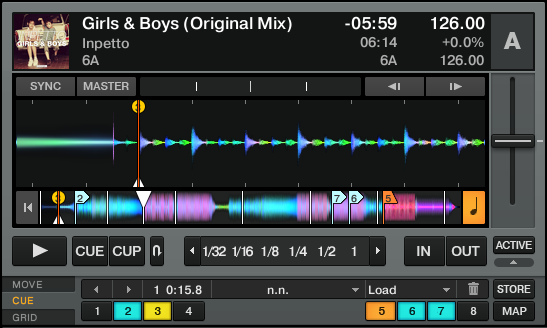
8. Girls & Boys
Mix in: Basic vocal mix. #3 is the quiet start leading into vocals at #2. Vocals ride on top of prior melody. Both tracks come down so naturally at the same time so I didn't add a #1 cue.
Mix out: getting ready for big drop. #7 is trigger, #6 is when new track comes in, and #5 is a hard stop.
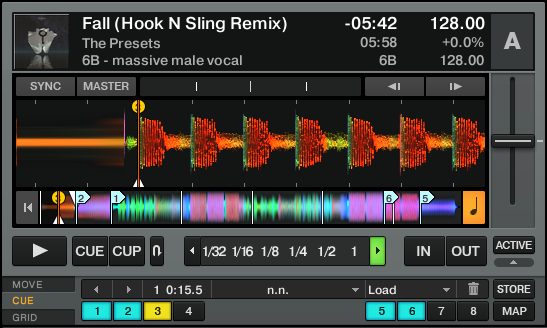
9. Fall
Great time to drop this track. I've been doing huge layers, but this time we'll drop down to a strong, stand-alone male vocal. Contrast. Track goes on a little long, but hey, it's cool. We needed a break by this point.
Mix in: #3 is early lead point, #2 is mix in with lots of little male vox stabs. I build those up until a massive drop into silence at #1.
Mix out: Finally, a basic mix out. Start at #6, end at #5.
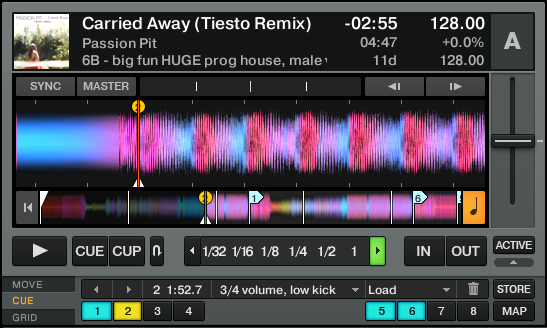
10. Carried Away
Mix in: Basic mix in. Drop w/ big audible synth horns, cut when the vocals come in at #1.
Mix out: Also pretty basic, but big contrast in sounds. #6 trigger, #5 soft exit.
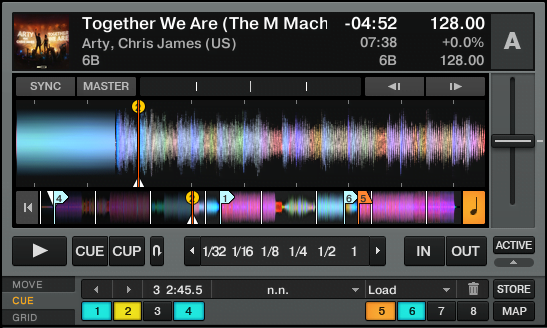
11. Together We Are
Another super-campy trance track, but brilliantly re-tuned by The M Machine. That's five vocal tunes in a row, so let's try something different: an industrial-noise breakdown. But the track is a little old, so let's not actually play the dance part. We'll use it as a bridge into something even bigger.
Mix in: Basic mix in. #2 is audible start, and full volume by #1's vocal.
Mix out: Quick soft mix out. #6 is trigger, completed by #5.

12. Echoes
Track blew me away when I first heard it, but then it was super cheesy. But it was that kind of uber-cheesy, like The Princess Bride, that you don't want to admit you want at first but please don't stop playing it. So I play the whole track.
Mix in: Soft mix in. #2 is audible low notes, and huge vocal hook at #1.
Mix out: A bit tricky and fast. We can't go for another round of this, so it's just 4 beats from drop #6 into hard cut by #5.

13. Stormwatch
Breezy happy, well-produced trance house to give listeners a break after Echoes.
Mix in: Fast tricky mix in. #2 has trance vox into #1 bass dropout. First non-harmonic mix (1B -> 3A), so there's more contrast and clear division.
Mix out: Just at hard cut-away at #5.
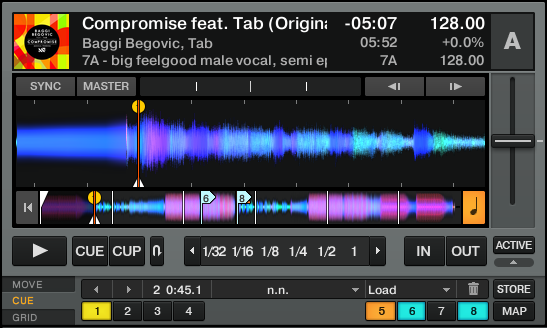
14. Compromise
Mix in: Nice drop (#1) into clean male vocal.
Mix out: Trigger at #6, hard cut-away at #5, just before end of phrase #8.

15. We Know
Another one I wanted to cut short but didn't. I needed the extra run from the end, so I would have had to edit post-mix. Wasn't such a big deal so I left it in as a breather for the big hard run that's about to start.
Mix in: Quiet lead at #3. Roll in the snares and vox for main vocal at #1.
Mix out: Trigger at #6, stop at #5. I think I drop it out a little earlier.

16. Cybertron
Always fun to sneak in a Far Too Loud track into a mix. A lot of great energy and new thinking applied to classic builds and motifs. It's the awesome crazy straw in your martini.
Mix in: Quiet lead at #3. Big buildup gets layered on, volume rising until big drop at #1.
Mix out: Sample mix - both tracks have same base riff here. Start at #6, cut away by #5, before end of phrase #8.
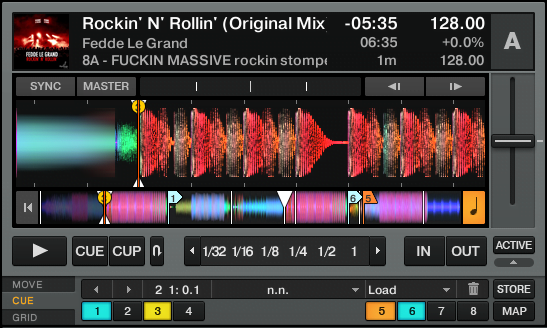
17. Rockin' N' Rollin'
You can only get away once with using the same riff twice in a row, so make it a good one. This track starts my favorite section of the mix - crazy hard techno.
Mix in: Quiet lead at #3. Big buildup gets layered on, volume rising until big drop at #1. Also a few cuts into Rockin' for vocal drops.
Mix out: Short mix. Intro new strings at #6, drop out by #5 before reprise.
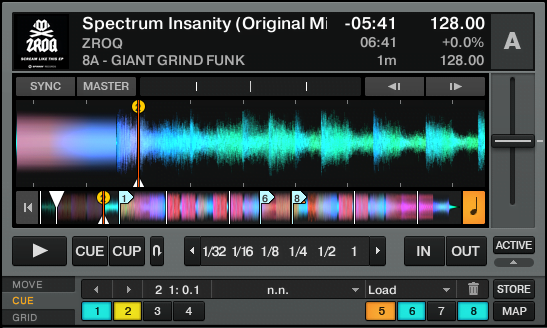
18. Spectrum Insanity
If you can't play tracks like this, what's the point of DJing?
Mix in: Big synth strings start playing right away at #2 w/ big bass hook at #1. Drop one note before #1 for the hand clap.
Mix out: Start layering at #6, cut away at #5 just before end of phrase #8.
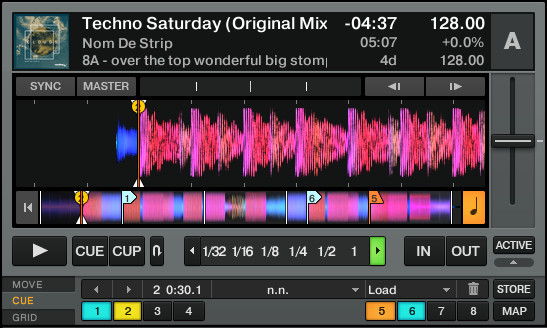
19. Techno Saturday
The death star has cleared the planet. I repeat, the death star has cleared the planet.
Mix in: low bass EQ, start playing #2 as counter notes, with build-up to #1.
Mix out: Just at hard cut-away at #5.
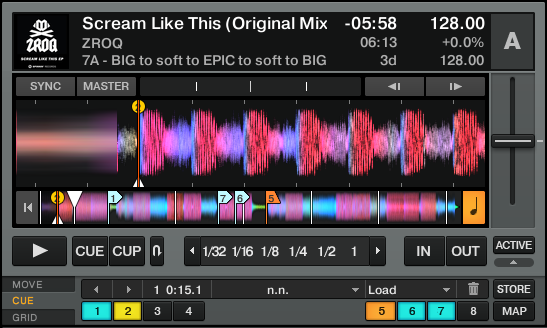
20. Scream Like This
Massive tension - hero vs protagonist. Simba fights Scar.
Mix in: low bass EQ, start playing #2 as counter notes, with build-up to #1.
Mix out: Quiet trigger at #7, strings start build at #6, and cut away by #5.

21. Stars
Another semi-cheesy vocal that only works in limited cases. In this case, it has this thing, like the vocals side of the mix is trying to force its way back in and shout over the hard techno, to take control and drown them back into place.
Mix in: Safe start w/ #3, start bringing in strings at #2, and big drop down at #1.
Mix out: Basic mix at #6 following dubstep breakdown, cut away by #5.
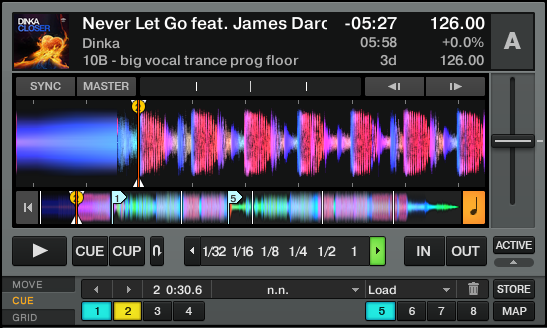
22. Never Let Go
More progressive trance vocals to restore some balance and get ready for finale.
Mix in: Soft mix level at #2, adding piano build-up until #1 breakdown.
Mix out: Start mixing at #5, let the drums in while fading out. No rush.
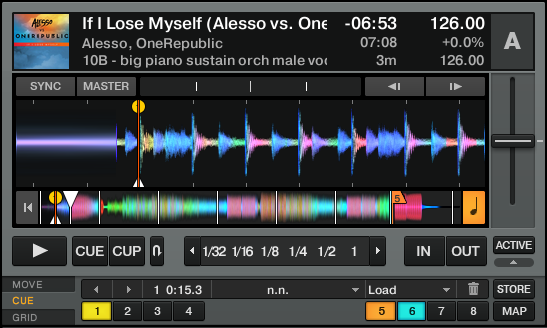
23. If I Lose Myself
Really like Alesso - bittersweet w/ such highs and lows.
Mix in: Start playing low snares at full volume, let the track lead the way.
Mix out: Fast tricky cut away at #6, must be clear by #5.
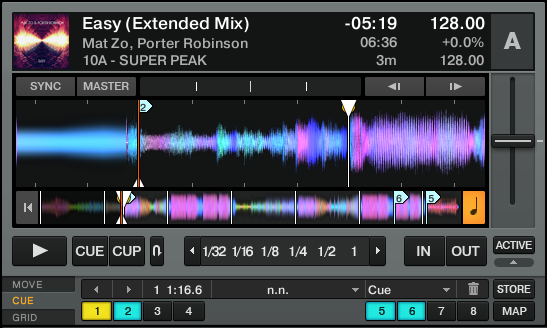
24. Easy
Big finale with something everyone will love. Such a happy track.
Mix in: Early 4-count at #2 w/ 2-count vocal lead into #1 drop. #1 is most likely starting point so I made it the Load Cue.
Mix out: basic mix out #6 until #5, but keep playing low.

25. Redux
Let's take the big happy track and extend it up as high as we can go.
Mix in: Basic mix in #2 to #1.
Mix out: Basic mix out #6 to #5.
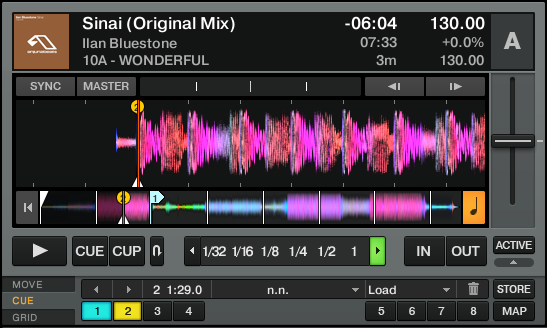
26. Sinai
Mix notes: Epilogue. Production level is less dynamic, so I fade out at the end of the breakdown, before the beats kicks in. Always leave them wanting more.
Mix in: Basic mix in #2 to #1.
Mix out: No markers. Fade out at the end of the breakdown.
Wrap Up
Wow, if you made it here... wow. This was long even for me.
I hope this gives you an idea of what it takes to put together a strong mix. It's a lot to look at, but when you're putting your mix together, it's quite easy. By the time you have everything in place, recording the mix is almost a formality. It'll be that easy.
Quick tip for dedicated souls: record your final mix at least twice and cherry pick the best parts during engineering ;-)

really cool job! ;)
I have a question on traktor sotware: how you (or software) chose the color of the visual wave of the music?! and why sometime the color change a lot in a clip?!?
A
Because I can do it in the mix
-P